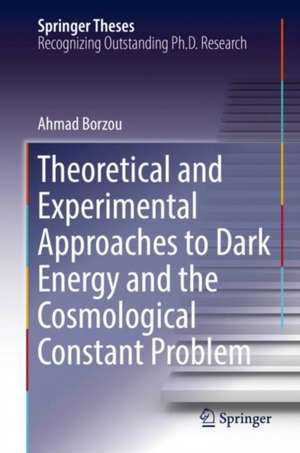Theoretical and Experimental Approaches to Dark Energy and the Cosmological Constant Problem: Springer Theses
Autor Ahmad Borzouen Limba Engleză Hardback – 28 noi 2017
| Toate formatele și edițiile | Preț | Express |
|---|---|---|
| Paperback (1) | 632.88 lei 6-8 săpt. | |
| Springer International Publishing – 23 mai 2018 | 632.88 lei 6-8 săpt. | |
| Hardback (1) | 638.24 lei 6-8 săpt. | |
| Springer International Publishing – 28 noi 2017 | 638.24 lei 6-8 săpt. |
Din seria Springer Theses
- 18%
 Preț: 997.88 lei
Preț: 997.88 lei -
 Preț: 389.88 lei
Preț: 389.88 lei - 15%
 Preț: 646.94 lei
Preț: 646.94 lei - 18%
 Preț: 943.43 lei
Preț: 943.43 lei -
 Preț: 399.29 lei
Preț: 399.29 lei - 18%
 Preț: 944.99 lei
Preț: 944.99 lei - 15%
 Preț: 636.80 lei
Preț: 636.80 lei - 18%
 Preț: 941.05 lei
Preț: 941.05 lei - 15%
 Preț: 643.16 lei
Preț: 643.16 lei - 15%
 Preț: 642.68 lei
Preț: 642.68 lei - 18%
 Preț: 1103.62 lei
Preț: 1103.62 lei - 20%
 Preț: 558.82 lei
Preț: 558.82 lei - 18%
 Preț: 1112.30 lei
Preț: 1112.30 lei - 18%
 Preț: 944.19 lei
Preț: 944.19 lei - 18%
 Preț: 1109.92 lei
Preț: 1109.92 lei - 18%
 Preț: 1217.27 lei
Preț: 1217.27 lei - 15%
 Preț: 640.06 lei
Preț: 640.06 lei - 15%
 Preț: 636.45 lei
Preț: 636.45 lei - 15%
 Preț: 640.06 lei
Preț: 640.06 lei - 15%
 Preț: 640.88 lei
Preț: 640.88 lei -
 Preț: 389.70 lei
Preț: 389.70 lei - 20%
 Preț: 563.89 lei
Preț: 563.89 lei -
 Preț: 393.35 lei
Preț: 393.35 lei - 15%
 Preț: 637.93 lei
Preț: 637.93 lei - 15%
 Preț: 641.85 lei
Preț: 641.85 lei - 18%
 Preț: 1225.94 lei
Preț: 1225.94 lei - 20%
 Preț: 551.36 lei
Preț: 551.36 lei - 18%
 Preț: 1229.10 lei
Preț: 1229.10 lei - 15%
 Preț: 639.25 lei
Preț: 639.25 lei - 18%
 Preț: 999.45 lei
Preț: 999.45 lei - 15%
 Preț: 640.06 lei
Preț: 640.06 lei - 18%
 Preț: 1220.45 lei
Preț: 1220.45 lei - 18%
 Preț: 1116.26 lei
Preț: 1116.26 lei - 18%
 Preț: 1110.72 lei
Preț: 1110.72 lei - 18%
 Preț: 1000.87 lei
Preț: 1000.87 lei - 18%
 Preț: 891.17 lei
Preț: 891.17 lei - 15%
 Preț: 640.06 lei
Preț: 640.06 lei - 5%
 Preț: 1154.07 lei
Preț: 1154.07 lei - 15%
 Preț: 635.96 lei
Preț: 635.96 lei - 15%
 Preț: 640.88 lei
Preț: 640.88 lei -
 Preț: 387.20 lei
Preț: 387.20 lei - 18%
 Preț: 1109.92 lei
Preț: 1109.92 lei -
 Preț: 385.25 lei
Preț: 385.25 lei -
 Preț: 385.25 lei
Preț: 385.25 lei - 18%
 Preț: 1112.30 lei
Preț: 1112.30 lei - 18%
 Preț: 999.45 lei
Preț: 999.45 lei -
 Preț: 386.99 lei
Preț: 386.99 lei - 15%
 Preț: 637.13 lei
Preț: 637.13 lei - 20%
 Preț: 554.20 lei
Preț: 554.20 lei - 20%
 Preț: 555.57 lei
Preț: 555.57 lei
Preț: 638.24 lei
Preț vechi: 750.88 lei
-15% Nou
Puncte Express: 957
Preț estimativ în valută:
122.15€ • 127.03$ • 102.22£
122.15€ • 127.03$ • 102.22£
Carte tipărită la comandă
Livrare economică 14-28 martie
Preluare comenzi: 021 569.72.76
Specificații
ISBN-13: 9783319696317
ISBN-10: 3319696319
Pagini: 111
Ilustrații: XV, 111 p. 42 illus., 33 illus. in color.
Dimensiuni: 155 x 235 mm
Greutate: 0.36 kg
Ediția:1st ed. 2018
Editura: Springer International Publishing
Colecția Springer
Seria Springer Theses
Locul publicării:Cham, Switzerland
ISBN-10: 3319696319
Pagini: 111
Ilustrații: XV, 111 p. 42 illus., 33 illus. in color.
Dimensiuni: 155 x 235 mm
Greutate: 0.36 kg
Ediția:1st ed. 2018
Editura: Springer International Publishing
Colecția Springer
Seria Springer Theses
Locul publicării:Cham, Switzerland
Cuprins
Chapter1. Introduction.- Chapter2. Dark Energy.- Chapter3. A Lorentz gauge theory of gravity.- Chapter4. Standard Model and Supersymmetry.- Chapter5. The Large Hadron Collider.- Chapter6. The Compact Muon Solenoid. Chapter7. Search for supersymmetry in the multijet and missing transverse momentum channel in pp collisions at 13 TeV.- Chapter8. Summary.
Textul de pe ultima copertă
This thesis represents a unique mix of theoretical work discussing the Lorentz theory of gravity and experimental work searching for supersymmetry with the Compact Muon Solenoid experiment at the Large Hadron Collider. It begins by reviewing a set of widely-discussed theoretical solutions to the cosmological constant problem, including a natural solution provided by the recently developed Lorentz gauge theory of gravity. The Schwartzschild metric, de Sitter space, and quantum versions of the theory are also discussed. The thesis then looks to supersymmetry for an alternative solution. The idea behind supersymmetry is reviewed and an experimental search for supersymmetry is presented. A major contribution was to estimate one of the most significant backgrounds in this search, which arises from top-antitop quark pair production or W boson production in association with multiple jets where the W boson decays into the hadronically-decaying tau leptons and neutrinos. This background was estimated through a novel method involving kinematically analogous events but including a well-measured muon. This search significantly extends limits on supersymmetric partners of gluons from previous searches.
Caracteristici
Nominated as an outstanding Ph.D. thesis by Baylor University, Texas Explores both theoretical and experimental solutions to the cosmological constant problem Summarizes and provides a review of several widely-discussed, recent theories relating to dark energy and the cosmological constant Describes a novel method to estimate one of the most significant backgrounds in the search for supersymmetry
